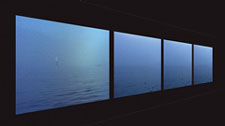Installations/ Expanded Cinema
| At
Sea
2003, A Four Channel Video Installation |
 |
|
At Sea is a fictional seascape constructed with a combination of digital image making technology, multiple DVD loops, and four screen video projection. The starting point for the work is the inability of the camera and the frame, as well as the inability of the viewer, to "see" the enormity of the ocean. What at first appears as documentation of a dense fog rolling over a sea vista, stretched across four projection screens is in fact a number of very separate images of the sea. These images are linked in terms of subject matter (the sea and the fog), image density, colour, scale, light, texture and line (horizon), and in the gallery, in the installation, these elements become linked in time as well as space. A number of video shots of the coast of British Columbia, (Canada) are projected side by side to form a single, continuous moving image. This image contains elements such as ships, buoys, floating driftwood, tree covered islets, sea birds, open ocean, and drifting fog banks. The dominant colour is grey; grey infused with a multitude of ocean blues and greens. The overall feel is somber and mysterious; a study of winter light falling on the surface of water and cloud; an evocative portrait of the Pacific North West. The material is encoded on four DVDs for continuous (looped) projection in the gallery. By placing the four projectors side by side, the impression of a continuous 40 ft x 8 ft image is created on the gallery wall. Speakers are placed in the four corners of the room. The sound of the ocean is occasionally punctuated by raucous sea birds, the ghostly echo of a distant fog horn and the sinister, almost sub audio, sound of a large cargo ship passing in the fog. In keeping with the image, the soundscape is spacious and largely empty, adding to the spatial ambiguity and dream like quality of the scene. Subtle changes in light and colour drift from screen to screen. As the "visibility" improves trees and ships appear to emerge out of the fog only to disappear back into the grain of the digital image. There are times when only the swirling fog and the steel grey expanse of ocean is visible. Gradually, as time passes, the same, half remembered, landmarks or events re-appear out of the fog, sometimes in the same place and sometimes on a completely different screen. I am reminded of T.S. Elliot's model of the mind in which a Groaner buoy chimes its somber bell, like consciousness itself, rocking to the uncharted swell of the unconscious. "And Under the oppression of the silent fog T.S. Elliot, from The Four Quartets. Through observation of the present, and memory of the past, the viewer may begin to "see" the seascape again, but this time as a digitally constructed fiction and not, as it first appeared, as a coherent pictorial space. While half seen objects hover on the threshold of visibility, viewers are invited to consider their own role in the construction of a fiction, a seascape that only exists in the moment of the projection event. In conventional continuity editing, pattern recognition and memory are used to turn a series of discontinuous spaces into the illusion of a continuous space. In this installation the process is reversed. At Sea starts with the illusion of continuous space and uses memory and pattern recognition to disrupt the spatial continuity of the image. This digitally constructed seascape can, in time, be framed and viewed in its entirety, from one end to another and from beginning to end. But the very constraints of this frame inevitably suggest there is more. One's understanding of the sea demands that there be more. The viewer's imagination moves beyond the limitations of pictorial space and another fiction is created. This second fiction, just like the sea, refuses to be framed and cannot be seen in its entirety. Perhaps this second seascape, this product of the human imagination, is the only thing we have that is even more mysterious than the vastness of the ocean itself?
|